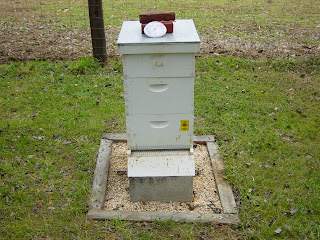 My bees might be done working outside the hive for the Winter, but I have a laundry list of beekeeping chores that need to be completed for this coming season. First, I am hoping for a good honey crop this year so I need to line up bottles and honey processing equipment. I came upon some used equipment, including the pictured honey extractor, that I want to rebuild for next season's harvest. It works well enough, but since it is an older galvanized model (unlike the newer stainless steel models) I want to paint with a product called Cambridge Coatings, which is a food use-approved clear coating that makes it easy to clean. Additionally, I want to build a stand to affix the extractor to, which will allow the hone to drain directly into a bucket that can be used to bottle the honey. Some other honey processing toys that I came across is a hot knife to cut the wax cappings off the frames, and a bunch of bee escapes that can be used to evacuate bees from the honey supers when harvesting. I also have some other extractors, but the one pictured is the one I will likely use. I still need to get a fume board and some cool bottles to put the honey in.
My bees might be done working outside the hive for the Winter, but I have a laundry list of beekeeping chores that need to be completed for this coming season. First, I am hoping for a good honey crop this year so I need to line up bottles and honey processing equipment. I came upon some used equipment, including the pictured honey extractor, that I want to rebuild for next season's harvest. It works well enough, but since it is an older galvanized model (unlike the newer stainless steel models) I want to paint with a product called Cambridge Coatings, which is a food use-approved clear coating that makes it easy to clean. Additionally, I want to build a stand to affix the extractor to, which will allow the hone to drain directly into a bucket that can be used to bottle the honey. Some other honey processing toys that I came across is a hot knife to cut the wax cappings off the frames, and a bunch of bee escapes that can be used to evacuate bees from the honey supers when harvesting. I also have some other extractors, but the one pictured is the one I will likely use. I still need to get a fume board and some cool bottles to put the honey in.I also want to get a second hive ready just in case I come across any swarms, be they from my hive or anyone else's. And of course, there are plenty of beekeeping books to read this Winter.



